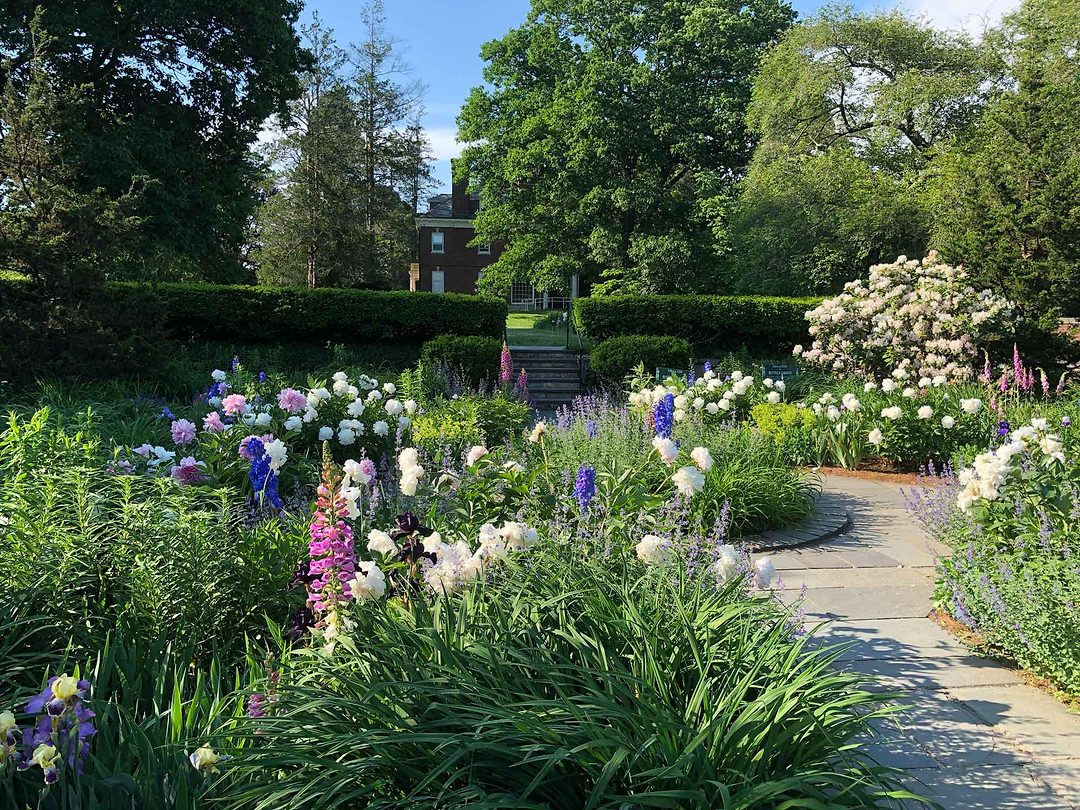The Buttrick Gardens at Minute Man National Historical Park look better than ever after several years of hardscape preservation projects that enhance the natural beauty of the historic gardens. Owned by the Buttrick family from the colonial period until the 1960s, the gardens were installed and expanded by three generations of the Buttrick family from 1911 to 1962, when they conveyed the property to the National Park Service.
The park recently rehabilitated the historic ironwork in the gardens, returning it to its former glory. The Buttrick Gardens include many fine examples of early to mid-twentieth-century wrought-iron gates, balustrades, and railings. The high-style ironwork is beautiful and functional, providing an elegant solution to the many steep overlooks and terraces that offer stunning views of the Concord River and the North Bridge. The black-painted wrought iron, with its curving scrolls and floral motifs, complements the garden’s colorful blooms from spring through fall and provides a lovely contrast to snowfall in winter. Preservation efforts included repairs, replacing missing elements, sanding, priming, and repainting the ironwork so that it will continue to adorn the gardens for years to come.

The ironwork preservation project also uncovered a few secrets in the Buttrick Gardens, including reclaimed gates and a secret pathway near the sunken garden. The Buttrick family installed two sets of ornate, arched gates to the sunken garden in the 1930s. One-half of the east gate had been missing for many years; staff member Margie Brown retrieved it from storage in a nearby park building. It is now restored and installed in the sunken gardens, welcoming visitors to pass through and explore the adjoining terrace garden.
The area beyond the west gates, locked for many years, revealed a secret bluestone pathway discovered and unearthed by one of our summer garden interns. As David Griffith explains, “Shortly after I started clearing the debris, all of a sudden, my shovel hit a stone. I kept digging, and before long, I had discovered an old pathway in the garden that had long been buried!”
With the pathway revealed and restored, visitors may now experience the Buttrick gardens uninterrupted, from the west slope garden to the sunken garden to the east terraces. Like many historic gardens of the twentieth century, the Buttrick Gardens comprise a series of interconnected garden “rooms” to explore. The stately ironwork helps to delineate each garden room and provides an intimate setting.

The ironwork restoration follows the brick, bluestone, and cobblestone pathway preservation project completed in the past few years. After a hundred years of use, many walkways had settled, were uneven, or contained broken stones. The preservation project included resetting, stabilizing, and replacing cracked stones, resulting in improved walking surfaces for visitors. The park hired skilled artisans to retain the historic integrity of the gardens while preserving the pathways and the project received a preservation award from the Town of Concord Historic Preservation Committee.
We welcome you to visit the newly restored Buttrick Gardens and discover all they have to offer. Whether you are looking for a spot to meet friends, a place for quiet contemplation, or as an inspiration for your next art project, the Buttrick Gardens are a must-see in Concord. The gardens are located at 174 Liberty Street, next to the North Bridge Visitor Center at Minute Man National Historical Park; they are free and open from dawn to dusk, year-round.
Donation information:
The Friends of Minute Man is the park’s non-profit partner and a proud supporter of the Buttrick Gardens. Your donation to the Friends of Minute Man Buttrick Gardens Fund provides seasonal maintenance, removal of invasive species, rejuvenation of historic plants, and reestablishing native pollinators. Visit FriendsofMinuteman.org/ Buttrick-Gardens to donate online or mail a check to The Friends of Minute Man National Park at 174 Liberty Street, Concord, MA.
All images ©Kathleen Fahey


